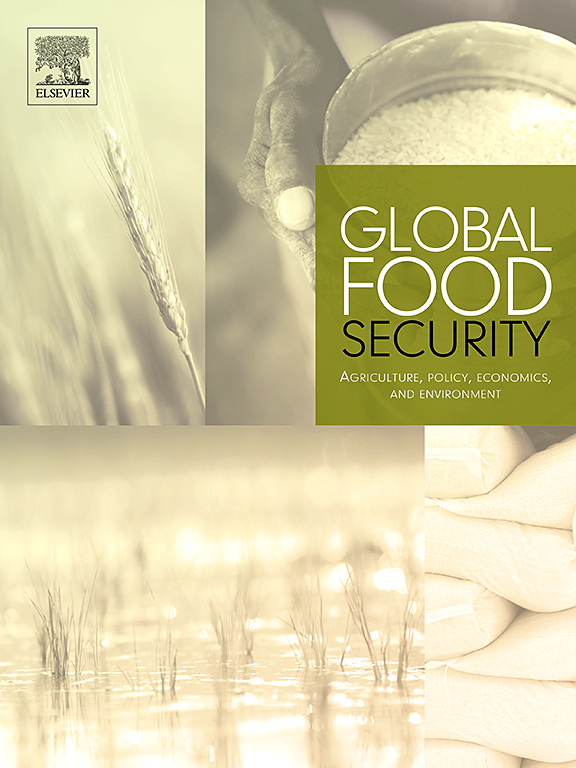Why do epidemics cause more hunger even when global food production is unaffected?
IF 9.6
1区 经济学
Q1 FOOD SCIENCE & TECHNOLOGY
Global Food Security-Agriculture Policy Economics and Environment
Pub Date : 2025-04-16
DOI:10.1016/j.gfs.2025.100848
引用次数: 0
Abstract
An apparent paradox is that, sufficient food is currently being produced to feed the global population, yet there has been a rising hunger in many parts of the world. An explanation that has been advanced in the literature lies in unfair food distribution within a specific region. However, empirical evidence regarding how infectious diseases influence people's food availability from a global food distribution perspective is still lacking. This paper aims to provide empirical evidence through investigating the effect of infectious diseases on hunger from the perspective of global food distribution. Using a panel data for 105 countries over the period of 1990–2016, we find that infectious diseases had no significant impact on overall global food production, but they caused more severe hunger in many countries or regions. How is that possible? The mechanism analysis shows that there was an increased flow of food from developing countries to developed countries during epidemics. Meanwhile, developing countries failed to compensate for this shortfall through either food stock or food aid, resulting in a reduced availability of food for domestic consumption. We find that epidemics caused higher domestic food prices and reduced affordability of food, which further exacerbated food insecurity and malnutrition in developing countries. To achieve the 2030 SDGs goal of Zero Hunger, it is critical to improve global food governance and enhance food distribution when facing a crisis such as epidemics.
为什么流行病会在全球粮食生产未受影响的情况下造成更多的饥饿?
一个明显的矛盾是,目前正在生产足够的粮食来养活全球人口,然而世界上许多地方的饥饿人数却在增加。文献中提出的一种解释是,特定地区的食物分配不公平。然而,从全球粮食分配的角度来看,关于传染病如何影响人们的粮食供应的经验证据仍然缺乏。本文旨在从全球粮食分配的角度考察传染病对饥饿的影响,提供经验证据。使用1990-2016年105个国家的面板数据,我们发现传染病对全球总体粮食生产没有显著影响,但它们在许多国家或地区造成了更严重的饥饿。这怎么可能呢?机制分析表明,在流行病期间,发展中国家向发达国家的粮食流量有所增加。与此同时,发展中国家未能通过粮食储备或粮食援助来弥补这一短缺,导致国内消费的粮食供应减少。我们发现,流行病导致国内粮食价格上涨,粮食负担能力下降,进一步加剧了发展中国家的粮食不安全和营养不良。为实现2030年可持续发展目标的零饥饿目标,在面临流行病等危机时,必须改善全球粮食治理,加强粮食分配。
本文章由计算机程序翻译,如有差异,请以英文原文为准。
求助全文
约1分钟内获得全文
求助全文
来源期刊

Global Food Security-Agriculture Policy Economics and Environment
FOOD SCIENCE & TECHNOLOGY-
CiteScore
20.90
自引率
3.40%
发文量
69
期刊介绍:
Global Food Security plays a vital role in addressing food security challenges from local to global levels. To secure food systems, it emphasizes multifaceted actions considering technological, biophysical, institutional, economic, social, and political factors. The goal is to foster food systems that meet nutritional needs, preserve the environment, support livelihoods, tackle climate change, and diminish inequalities. This journal serves as a platform for researchers, policymakers, and practitioners to access and engage with recent, diverse research and perspectives on achieving sustainable food security globally. It aspires to be an internationally recognized resource presenting cutting-edge insights in an accessible manner to a broad audience.
 求助内容:
求助内容: 应助结果提醒方式:
应助结果提醒方式:


